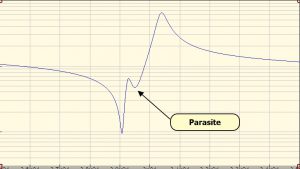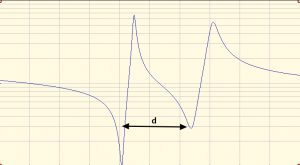Content reserved for our customers.
Tras analizar un sonotrodo roto con oMETER, el gráfico obtenido mostrará:

After analyzing a broken horn with oMETER, the obtained graph will show:

Horns can vibrate in different ways other than the normal (longitudinal) way. Longitudinal excitation often causes lateral or mixed vibrations that overlap the main one.
When the distance between the resonant frequency and the parasitic frequency is less than 1000 Kz, the horn is likely to malfunction


When the parasitic frequency is between the resonant frequency (lowest point) and the anti-resonance frequency (highest point), the horn will not work.
The modulus of elasticity of titanium, aluminum and steel varies slightly between different batches of the same material.
Therefore, during the manufacturing process, the measurements must be adjusted to the specific characteristics of the batch.
On the PRODUCE-> SPARE PARTS -> METHOD page there is a detailed and complete guide on the method to follow to adjust these dimensions
Los sonotrodos pueden vibrar de diferentes formas además de la forma normal (longitudinal). Frecuentemente la excitación longitudinal provoca vibraciones laterales o mixtas que se superponen a la principal.
Cuando la distancia entre la frecuencia de resonancia y la frecuencia parásita es menor de 1000 Kz, es probable que el sonotrodo funcione mal


Cuando la frecuencia parásita se encuentra entre la frecuencia de resonancia (punto mas bajo) y la frecuencia de anti-resonancia ( punto más alto), el sonotrodo no funcionará.
El módulo de elasticidad del titanio, aluminio y acero varía ligeramente entre distintos lotes del mismo material.
Por ello, durante el proceso de fabricación, se deben ajustar las medidas a las características específicas del lote.
En la página FABRIQUE –> RECAMBIOS –> METODO hay una guía detallada y completa del método a seguir para ajustar dichas medidas.